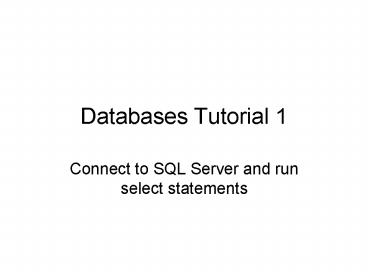Databases Tutorial 1 - PowerPoint PPT Presentation
1 / 13
Title:
Databases Tutorial 1
Description:
Databases Tutorial 1 Connect to SQL Server and run select statements Tutorial 1 Databases Simple selects Add comments to SQL code Add comment to output Continue after ... – PowerPoint PPT presentation
Number of Views:161
Avg rating:3.0/5.0
Title: Databases Tutorial 1
1
Databases Tutorial 1
- Connect to SQL Server and run select statements
2
Tutorial 1 Databases
- Simple selects
- Add comments to SQL code
- Add comment to output
- Continue after an error
- Restrict rows
- Restrict columns
- Conditions
3
Simple selects
- The full syntax of the SELECT statement is
complex, but the main clauses can be summarized
as - SELECT select_listINTO new_table_nameFROM
table_listWHERE search_conditionsGROUP BY
group_by_listHAVING search_conditionsORDER
BY order_list ASC DESC - In this lesson, we will address only those
clauses in black.
4
Select list
- Describes the columns of the result set. It is a
comma-separated list of expressions. - Each expression defines both
- the format (data type and size) and
- the source of the data for the result set column.
- Each select list expression is usually a
reference to a column in the source table or view
the data is coming from, but can be any other
expression, such as a constant or a Transact-SQL
function. - Using the expression in a select list specifies
that all columns in the source table are returned.
5
FROM table_list
- Contains a list of the tables from which the
result set data is retrieved. These sources can
be - Base tables in the local server running
Microsoft SQL Server. - Views in the local SQL Server. SQL Server
internally resolves a view reference to
references against the base tables that make up
the view. See later in the course.
6
Simplest select
- Select from lttable-namegt
- E.g. Select from dog
7
WHERE search_conditions
- The WHERE clause is a filter that defines the
conditions each row in the source tables must
meet to qualify for the SELECT. - Only rows that meet the conditions contribute
data to the result set. - Data from rows that do not meet the conditions
are not used.
8
Selection
- Selection picks individual columns from a table
9
Projection
- Projection picks only rows that satisfy a
condition
10
Conditions
- And, or not
- Equal, not equal, greater than, less than.
- Like, using and
11
Miscellaneous
- To comment out parts of a query, surround the
part by // - To make the analyser pick up after an error or
break, use the word GO - To denote a string, use single quotes. Double
quotes are not recognised. - If you want to embed a single quote (i.e. an
apostrophe!) in a string, precede it with another
single quote.
12
Example
13
Further exercises
- Try out the where clause on the sample
database, changing the conditions.

